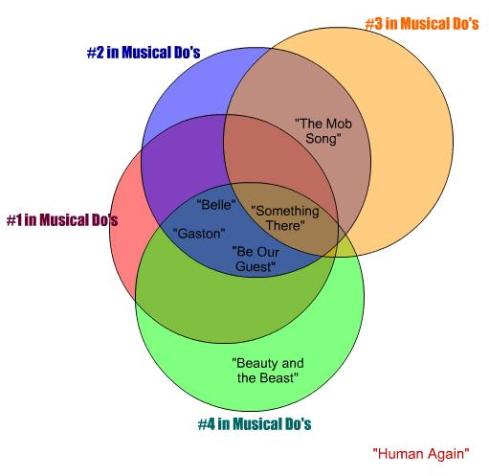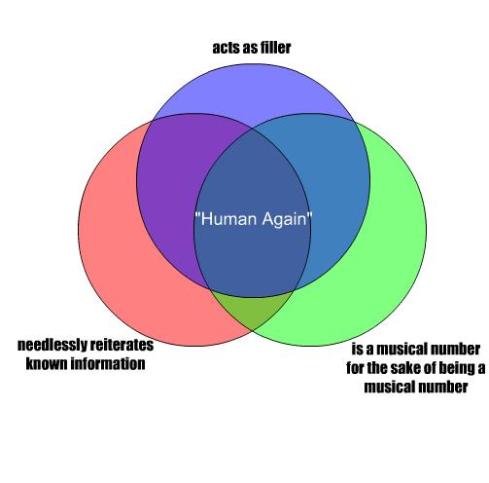
Sometimes, musicals are weird.
The idea behind musicals is great. Use song and dance to:
Musical Do’s:
1. Engagingly and rapidly present story elements like expository information, characters, setting, etc.
2. Externalize unstated character conditions, motivations, intra/interpersonal mood, subtextual stuff
3. Streamline pacing for situations involving change, like mounting conflict or montages
4. Include fun, catchy, and/or evocative (perhaps melodically beautiful) musical content that audiences can associate with story as a whole
When musical numbers don’t solidly perform one or more of these four functions, that doesn’t necessarily make them bad. It does, however, make them musical numbers for the sake of musical numbers; they don’t enrich the story in any way besides their intrusion-by-existence. Your story is moving along smoothly or unsmoothly or what have you and SUDDENLY there’s this extraneous and unremarkable musical number that just appears, almost as if it wants to waste time. So here’s a second list containing faux pas musical number functions:
Musical Don’t’s
1. Needlessly reiterate already obvious story elements, character conditions, etc.
2. Act as filler to artificially extend play time
3. Exist as a musical number simply for the sake of being a musical number
These are fuzzy rules, so here’s an example that touts them left and right. The Scrubs musical episode already wades into #3 simply by existing; it is a pointed musical episode in a show that contains no other musical episodes, written obviously to satisfy the writers’ collective thirst for a musical episode. Right from the get-go, the very first two musical numbers display the device responsible for everyone’s apparent singing (a patient with a brain injury), which is a waste of time because a musical number should not have to explain why it exists UNLESS it contributes to the story in an embedded fashion.
Since that last morsel was a mouthful, consider another example to illustrate. Buffy‘s “Once More With Feeling”, too, is a musical episode in a show otherwise bereft of musicals. Prior to writing/filming OMWF, Joss Whedon had long wanted to do a musical episode. As with the Scrubs musical episode, this begins to stink of #3: musicals for the sake of themselves. There are even a couple songs (“I’ve Got a Theory” and “What You Feel”) that address the singing itself, a maneuver which stumbles into the realm of musical numbers explaining their own existence. However, in OMWF, the singing is a literal truth within the story, whereas in Scrubs it’s only perceptual. As such, in the former, we have singing addressing its own existence because it is actually happening and actually strange. In the latter, we have singing addressing its own existence because the writers have to explain what their excuse for having a musical episode is, even if no one is actually singing in the plot. See the difference?

Let’s take the comparison further. OMWF is a critical episode in season 6 of Buffy; practically everyone’s secrets are revealed (#2 on the musical Do list) and seeds for change (Giles leaving Sunnydale and Tara leaving Willow) are sown (#3 on the Do list). The musical numbers are embedded in the story because their existence, albeit strange, catalyzes characters and events relevant to the story as a whole. In addition, on an artsy-fartsy note, the externalization of otherwise unstated character conditions (like Xander and Anya’s uncertainties about each other) being a literal truth within the season 6 story comments ironically on the brazenness of musical numbers and the vulnerability of private thoughts/feelings. The Scrubs musical episode, on the other hand, contributes to the story of season 6 Scrubs by… um… well, it’s the musical episode! And musicals are fun, right? Who cares if almost every song is simply a reiteration of content established in previous episodes (“Guy Love”, “Welcome to Sacred Heart”, “The Rant Song”: #1 on the Don’t list) or an explanation of the musical’s existence? Oh, oh– J.D. and Elliot stopped living together! That totally couldn’t have happened unless they were part of a perceived musical! Right? Right?
Bearing the discussion above in mind, this post was actually intended to address a certain superfluous track *cough* “Human Again” *cough* added to the 2002 special edition of Disney’s Beauty and the Beast (sidetracked much?). In terms of critical reception, Beauty and the Beast is the crown jewel of the Disney Renaissance; it’s got great visuals, great writing, great characters, and–most important to this discourse–really great music. From the gorgeously haunting introduction (“Prologue”) to the titular musical number “Beauty and the Beast” and all the way through the closing piece (“Transformation”), Alan Menken composes up a storm of totally unforgettable, excellent scoring for this film. Anyone who has seen it can recognize the songs in a heartbeat. As such, #4 on the Do list is out of the ballpark for Beauty and the Beast.

Other items on the Do list (tired of scrolling yet?) have representation in Beauty and the Beast as well; “Something There” melodiously narrates, in montage form, changes in Belle’s and the Beast’s feelings towards one another (#3). “The Mob Song”, too, connects scenes related to the mobilization of village people attacking the Beast. These are purposeful songs; not only do they guide events, but they also display internal feelings of the people involved in said events (#2 on the Do list). “Belle”, “Gaston”, and “Be Our Guest” fall into a category between #1 and #2; they establish motivation for Belle, Gaston, and the castle servants as well providing expository information about the social climate of Belle’s provincial life (they’re all quite memorable, to boot). The richness of content in these musical numbers sets a standard not to be taken lightly, but some people just have no sense.
The 2002 special edition of Beauty and the Beast has some nice revamps on visuals, but it also contains this awful musical outlier called “Human Again” in the otherwise quality-driven set of musical numbers. “Human Again” is effectively this: the Beast’s castle servants relish the notion of being human again (appropriately enough) while cleaning the castle in preparation for Belle and the Beast’s big dance date. They basically prepare the castle for a better musical number (“Beauty and the Beast”). Prior to this song, we already know that these characters are excited to be human again; otherwise, they wouldn’t be so hospitable and kind towards Belle (#1 on the Don’t list). Dialogue and visuals preceding and following “Human Again” also demonstrate that the castle has been cleaned, so the events shown during the musical number are both boring (it’s cleaning for goodness’s sake) and redundant, making it filler (#2 on the Don’t list). In addition, this was a song added to a re-release in order to boost sales; a bonus musical number is probably not adding anything special and exists primarily as “a bonus musical number!” and thus demonstrates even #3 on the Don’t list. Musically, the song is rather mediocre and can’t even salvage its reputation with #4 on the Do list. Honestly, “Human Again” is just utter rubbish and it’s a shame anyone felt it necessary to sully a stellar film with its complete uselessness.
I have Venn diagrams, so this is totally legit.


